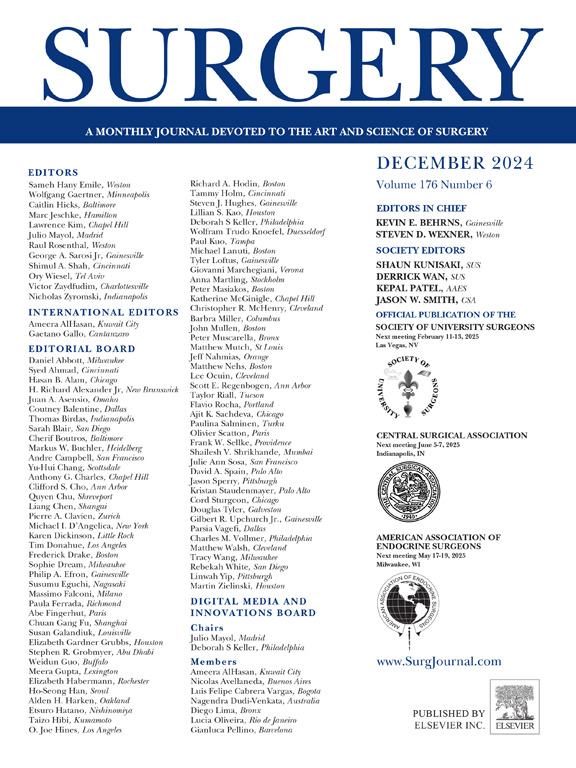A systematic review of lymphovenous anastomosis to treat nontraumatic chylous anasarca
IF 2.7
2区 医学
Q1 SURGERY
引用次数: 0
Abstract
Background
Anomalies in chyle flow, obstructive, functional or malformative, are responsible for leakage of chyle into the peritoneal, pericardial, or pleural spaces. Although rare, chronic chylous effusions can have disastrous consequences. Current treatments do not provide permanent and satisfactory solutions. Lymphovenous anastomosis can be a suitable treatment in this context; however, it needs to be fully evaluated regarding its efficacy, indications, and means of achievements. The objective of the study is to assess the efficacy of lymphovenous anastomosis to treat nontraumatic chylous anasarca.
Methods
Following Preferred Reporting Items for Systematic Reviews and Meta-Analyses guidelines, a systematic review of the literature was made using PubMed, ScienceDirect, and the Cochrane library from databases creation to August 2024 to analyze all patients reported to have undergone lymphovenous anastomosis for nontraumatic chylous leakage. Quality assessment of studies was performed with Joanna Briggs Institute Manual for Evidence Synthesis assessment tools and Methodological Index for Non-Randomized Studies. Results were presented in table summaries.
Results
In total, 14 studies matching inclusion criteria (human subjects, articles in English or French, whose main subject was chylous effusion management) were identified (9 case reports, 5 case series), representing 48 patients treated via lymphovenous anastomosis. The indications reported were mostly thoracic duct obstruction or malformation. Lymphovenous anastomosis was at least partially successful in 35 patients (74%), the condition was completely resolved in 27 patients (57%). Only a few complications were reported.
Conclusion
Lymphovenous anastomosis could be a suitable treatment for nontraumatic chylous effusions but requires further evaluation via prospective cohort studies with more patients to define indications and methods and evaluate long-term outcomes for better management.

淋巴静脉吻合术治疗非外伤性乳糜缺失的系统综述
背景:乳糜流异常(梗阻性、功能性或畸形性)可导致乳糜渗漏至腹膜、心包或胸膜间隙。虽然罕见,慢性乳糜积液可造成灾难性的后果。目前的治疗方法不能提供永久和令人满意的解决办法。在这种情况下,淋巴静脉吻合是一种合适的治疗方法;然而,需要对其疗效、适应症和成就手段进行充分评价。本研究的目的是评估淋巴静脉吻合术治疗非创伤性乳糜缺失的疗效。方法按照系统评价和荟萃分析的首选报告项目指南,使用PubMed、ScienceDirect和Cochrane图书馆从数据库创建到2024年8月的文献进行系统评价,分析所有报道的接受淋巴静脉吻合术治疗非创伤性乳糜漏的患者。采用乔安娜布里格斯研究所证据综合评估工具手册和非随机研究方法学指数对研究进行质量评估。结果以表格摘要的形式呈现。结果共纳入14项符合纳入标准的研究(人类受试者,以乳糜积液管理为主要主题的英文或法文文章)(9例报告,5例系列),共48例经淋巴静脉吻合术治疗的患者。报告的适应症主要是胸导管阻塞或畸形。淋巴静脉吻合至少部分成功35例(74%),完全治愈27例(57%)。仅有少数并发症被报道。结论淋巴静脉吻合术可能是治疗非外伤性乳糜积液的合适方法,但需要通过更多患者的前瞻性队列研究来确定适应症和方法,并评估长期疗效以获得更好的治疗。
本文章由计算机程序翻译,如有差异,请以英文原文为准。
求助全文
约1分钟内获得全文
求助全文
来源期刊

Surgery
医学-外科
CiteScore
5.40
自引率
5.30%
发文量
687
审稿时长
64 days
期刊介绍:
For 66 years, Surgery has published practical, authoritative information about procedures, clinical advances, and major trends shaping general surgery. Each issue features original scientific contributions and clinical reports. Peer-reviewed articles cover topics in oncology, trauma, gastrointestinal, vascular, and transplantation surgery. The journal also publishes papers from the meetings of its sponsoring societies, the Society of University Surgeons, the Central Surgical Association, and the American Association of Endocrine Surgeons.
 求助内容:
求助内容: 应助结果提醒方式:
应助结果提醒方式:


